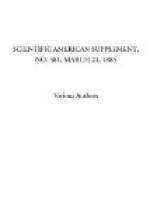Fire-alarms are used in America; but in England, also, the fire systems of Edward Bright, Spagnoletti, and Higgins have been introduced, and in that respect we are in very near the same position as our friends on the other side of the Atlantic. Some members present may remember that, when I described my last visit to America, I mentioned how in Chicago the fire-alarm was worked by an electric method, and I told you a story then that you did not believe, and which I have told over and over again, but nobody has yet believed me, and I began to think that I must have made a mistake somewhere or other. So I meant, when at Chicago this time, to see whether I had been deceived myself. There was very little room for improvement, because, as I told you before, they had very near reached perfection. This is what they did: At the corner of the street where a fire-alarm box is fixed, a handle is pulled down, and the moment that handle is released a current goes to the fire-station; it sounds a gong to call the attention of the men, it unhitches the harness of the horses, the horses run to their allotted positions at the engine, it whips the clothes off every man who is in bed, it opens a trap at the bottom of the bed and the men slide down into their positions on the engine. The whole of that operation takes only six seconds. The perfection to which fire-alarm business has been brought in the States is one of the most interesting applications of electricity there.
Of course during this visit I waited on Mr. Edison. Many of you know that a difference took place between Mr. Edison and myself, and I must confess that I felt a little anxiety as to how I should be received on the other side. It is impossible for any man to receive another with greater kindness and attention than Mr. Edison received me. He took me all over his place and showed me everything, and past differences were not referred to. Mr. Edison is doing an enormous amount of work in steadily plodding away at the electric light business. He has solved the question as far as New York is concerned and as far as central station lighting is concerned; and all we want on this side is to instill more confidence into our capitalists, to try and induce them to unbutton their pockets and give us money to carry out central lighting here.
I met another very distinguished electrician—a man who has hid his light under a bushel—a man whose quiet modesty has kept him very much in the background, but who really has done as much work as any body on that side of the Atlantic, and few have done more on this—and that is Mr. Edward Weston. He is an Englishman who has established himself in New York. He has been working steadily for years at his laboratory, and works and produces plant with all the skill and exactitude that the electrician or mechanic could desire.
Another large factory I went over was that of the Western Electric Company of Chicago, which is the largest manufactory in the States. That company has three large factories. While I was there, the manager, just as a matter of course, handed me over a message which contained an order for 330 arc lamps and for twenty-four dynamo machines. He was very proud of such an order, but he tried to make me believe that it was an every-day occurrence.




